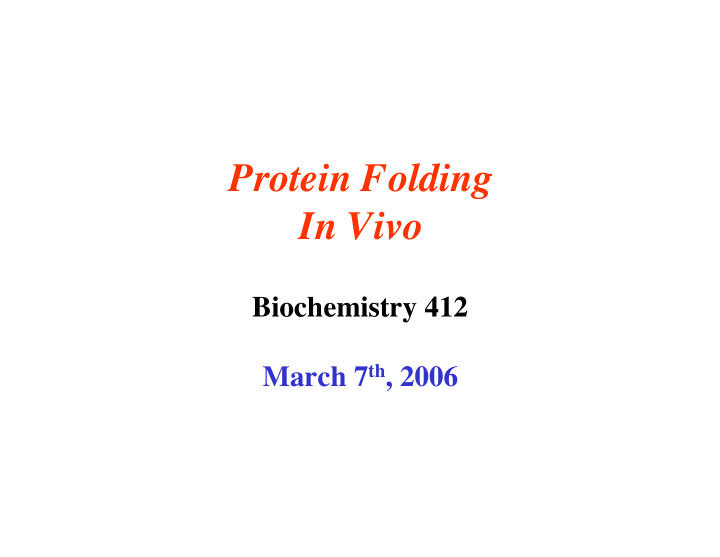



Protein Folding In Vivo Biochemistry 412 March 7 th , 2006
But first, before we talk about in vivo phenomena… some more theory!
Computational Protein Folding How are the theorists doing lately?
Baker (2000) Nature 405 , 39.
Progress in de novo protein structure prediction & design Schueler-Furman et al (2005) Science 310 , 638.
Present protein folding theory suggests that proteins must find the right polypeptide chain topology (“topomer”) first, then they can form 2° structure and snap into the correct 3D conformation relatively quickly. Gillespie & Plaxco (2004) Ann. Rev. Biochem. 73 , 837.
Dobson (2003) Nature 426 , 884.
Calculating structures with their associated energies: Deep & narrow energy wells are a hallmark of near-correct structures Schueler-Furman et al (2005) Science 310 , 638.
For small, single domain proteins, some of the predictions are getting very good! Schueler-Furman et al (2005) Science 310 , 638.
You, too, can do theoretical protein folding with David Baker!! See http://boinc.bakerlab.org/rosetta But make sure your computer doesn’t overheat!
Protein Folding In Vivo Molecular Chaperones
Dobson (2003) Nature 426 , 884.
Hartl & Hayer-Hartl (2002) Science 295 , 1852.
Hartl & Hayer-Hartl (2002) Science 295 , 1852.
Hartl & Hayer-Hartl (2002) Science 295 , 1852.
Folding of membrane proteins in the cell
Two stages of membrane protein folding Bowie (2005) Nature 438 , 581.
Mechanistic model for membrane protein insertion Bowie (2005) Nature 438 , 581.
Protein degradation in the cell Natural turn-over as well as removal of defective proteins
Protein Degradation In Vivo Goldberg (2003) Nature 426 , 895.
Nature’s meat grinder: Misfolded proteins are degraded (and ultimately recycled to their constituent amino acids) by the proteasome Goldberg (2003) Nature 426 , 895.
Protein Folding and Disease
Dobson (2003) Nature 426 , 884.
Some examples (of many!) of human diseases where amino acid substitutions (mutations) cause pathological protein misfolding • Sickle cell anemia - The Glu6 --> Val mutation in the beta subunit changes the solubility properties of hemoglobin, causing aggregation and shape changes in the red blood cells (see http://sickle.bwh.harvard.edu/scd_background.html) • Emphysema - Alpha-1 antitrypsin regulates the activity of elastase in the lungs; too much elastase activity can cause destruction of lung tissue. Mutations in the gene for alpha-1 antitrypsin cause misfolding during its synthesis in the liver, which then leads to defective export from liver cells and a deficiency in the lungs (see http://health.enotes.com/genetic-disorders- encyclopedia/alpha-1-antitrypsin). • Alzheimer’s disease - Mutations in a gene product called “APP”, or in APP processing enzymes, can cause build-up of a peptide breakdown product. This peptide (known as beta peptide) can aggregate into so-called amyloid fibrils , which can form deposits (known as plaques ) that build up over time in the brain, killing neurons (see Selkoe [2001] Neuron 32 , 177).
Model structures for amyloid peptide fibrils (note: these are not Alzheimer’s amyloid peptide fibrils, but the structures are thought to be similar) Chien et al (2004) Ann. Rev. Biochem. 73 , 617.
Electron micrographs of various amyloid fibril preparations Chien et al (2004) Ann. Rev. Biochem. 73 , 617.
Prions also form amyloid-like deposits and fibrils (see next slide) Chien et al (2004) Ann. Rev. Biochem. 73 , 617.
Electron micrographs of amyloid-like fibers formed by prions Chien et al (2004) Ann. Rev. Biochem. 73 , 617.
What about therapeutic interventions in “protein folding-opathies”? For example, can pharmacological rescue of misfolded and/or misrouted proteins be achieved in vivo ? Guess what, yes! It works!!
GnRHR has many known mutations that disrupt its folding and sorting within the cell. Ulloa-Aguirre et al (2004) Traffic 5 , 821.
Note: the exogenously added drug Ulloa-Aguirre et al (2004) Traffic 5 , 821.
Ulloa-Aguirre et al (2004) Traffic 5 , 821.
Recommend
More recommend